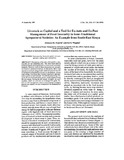Livestock as Capital and a Tao I for Ex-Ante and Ex-Post Management of Food Insecurity in Semi-traditional agro-pastoral societies:an example from South East Kenya
| dc.contributor.author | Nyariki, Dickson M. | |
| dc.date.accessioned | 2017-02-25T07:56:32Z | |
| dc.date.available | 2017-02-25T07:56:32Z | |
| dc.date.issued | 1999 | |
| dc.identifier.uri | http://hdl.handle.net/123456789/222 | |
| dc.identifier.uri | https://www.tandfonline.com/doi/abs/10.1080/09718923.1999.11892229 | |
| dc.identifier.uri | https://www.researchgate.net/publication/321218447_Livestock_as_Capital_and_a_Tool_for_Ex-Ante_and_Ex-Post_Management_of_Food_Insecurity_in_Semi-Traditional_Agropastoral_Societies_An_Example_from_South-East_Kenya | |
| dc.identifier.uri | http://erepository.uonbi.ac.ke/handle/11295/50666 | |
| dc.description.abstract | Discussions of the roles of livestock in many societies is not something new. They have been done in anthropological, sociological and, to some extent, economic literature. However, most of these discussions are normally not based on statistical evidence. In this paper, there is an attempt to evaluate using simple statistical analysis the role of livestock in household economy in sub-Saharan African rural setting. It is shown that livestock keeping in agro-pastoral systems is multi-faceted. Households possessing livestock till more land and realize greater yields of grain during the wet season. During the dry season, livestock are commodities, which are sold and or exchanged for grain. Extant or risk management and ex-post (coping) strategies against food scarcity are also enhanced by the possession of livestock. Key Words: Food Security, Livestock Capital, Risk Management, Coping, Agro-Pastoralists | |
| dc.language.iso | en | en_US |
| dc.title | Livestock as Capital and a Tao I for Ex-Ante and Ex-Post Management of Food Insecurity in Semi-traditional agro-pastoral societies:an example from South East Kenya | en_US |
| dc.type | Article | en_US |
Files in this item
This item appears in the following Collection(s)
-
Journal Articles (BE) [401]

